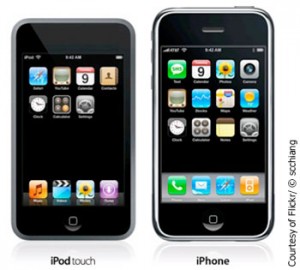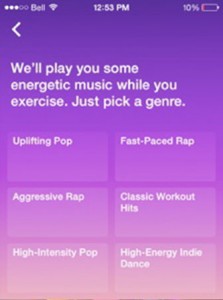Tags
Related Posts
Share This
Death of the iPod?
Previously poised to conquer the world in 2002 and 2003, the once mighty iPod is on the decline. According to recent statistics, sales of the iPod Classic have significantly decreased. Currently it seems ready to go the way of the walkman and the VHS player, other hardware elements that have become obsolete.
Numbers don’t lie
The revenue for the iPod business has dropped by 31 percent “year-over-year,” says Craig Lloyd, a technology expert and writer for Slashgear, a technology blog. In the fourth quarter of 2011, iPod sales were down 27 percent from the previous year, and the number of iPod units sold dropped 32 percent from the previous year. Lloyd says this doesn’t come as much of a surprise, since the iPod has been on a downward trend for a while now.

No contest. Do we still need the iPod, when the iPhone does essentially the same thing and more?
By contrast, there has been an “exponential increase” in active listeners of online music apps in the past few years, according to David Porter, CEO of 8tracks. The best way to measure internet radio success is through monthly active users and listener hours, rather than the amount of people who have downloaded this app, he says. In Sept. 2011, the listener hours (sum total of all hours streamed) were three million; in Sept. 2012, 10 million; and in Sept. 2013, it had grown to 26 million.
Among reasons for the decline in iPod sales, surely a major one is that young users are turning to their cell phones for music. Consumers aren’t buying iPods because iPhone, Blackberry and Android devices can play music, too. “Essentially, consumers are thinking, Why would I carry around a phone and an iPod when I can have both in one device?” says Lloyd.
Advantages of online music apps
Cell phones do not offer as much space for music in stored files; however, people can download a variety of streaming apps. There are some great new streaming apps available, including Songza and 8tracks, which have many advantages over the mighty iPod.
Foremost, the price is a lot cheaper: An app costs far less than an iPod. Apps like Songza and 8tracks are free for users. Others apps, like Storify, which have the ability for offline access, cost $10 a month, according to Lloyd — still much cheaper than an iPod. “People are happy to spend $10 per month for premium music services,” Lloyd says.
‘Consumers are thinking, Why carry a phone and an iPod when I can have both in one device?’ — technology writer Craig Lloyd
Another advantage is the potential to discover new music.
Streaming apps gives listeners that “radio” experience, but vastly improved per choice, timing and demand. These kinds of apps are great for when the listener wants to hit “Play” and listen to music. There is no predictability with these streaming apps, and that is what entices people to use them. If the listener doesn’t like a song that comes on, he or she just hits “Next” and a fresh beat will play. Also, the amount that you can stream through these apps is limitless.

Carleton student Cynthia Winker listens to Songza because she prefers its spontaneity, over her iPod playlist.
Just like the radio, music apps allow people to discover new music that they wouldn’t have otherwise uncovered, explains Porter. But music on the radio tends to be stale and overplayed. These online streaming playlists are much more colourful and creative.
That is because the apps are well curated. At Songza, playlists are curated by a network of music experts including disc jockeys, musicologists, music writers and music journalists, who hand pick music. Megan Green, Senior Director of Business Development at Songza, explains that some playlists are updated more frequently than others, depending on how often they are streamed, to give the listeners a variety.
“I basically use it because of their fresh and upbeat songs; it’s a good change from my playlist,” says Peter Kavcic, 22, a Carleton University student. “It really is a lot more refreshing than the same old songs on your own iTunes workout playlist.”
This is also part of a generational shift in values. Younger listeners don’t care to own music, whether purchased or downloaded-for-free. Younger listeners are happy to stream.
Why buy?
Consumers have moved away from buying songs to simply wanting to access the music. It saves space on their devices, too. It doesn’t matter whether they own the songs or not; as long as they can access the music, these listeners are content. Users cannot choose a certain song while listening to these apps, but they can choose particular playlists that offer songs within that same genre.
According to Porter, only about 20 per cent of people in the United States actually buy music. The younger generations don’t buy; they assume it should be free because of all the types of free online streaming services. The main demographic that still buys music is the middle range: thirty-somethings who want to remain loyal to a particular artist or band.
“I would agree [iPods] are becoming obsolete for the most part, but there are still some people who need an iPod because the iPhone only holds 64GB of files, and I know a few people that have music libraries larger than that. Those people still use their iPod Classics today,” says Lloyd.
Nevertheless, with smart-phones here to stay and streaming increasing exponentially, it seems safe to say “R.I.P. iPod.”
Home-page photo © Christina Pellegrini.
Sidebar photo courtesy of Songza.
How these apps are curated
To make a successful app, the producers need first to understand how their clients consume music. People consume music in a very laid-back way, according to Megan Green, Senior Director of Business Development at Songza. Green explains that Songza helps music listeners find the perfect playlist by asking listeners what they are doing or how they are feeling, and the site then guides the listener to an appropriate playlist.
“I listen to 8tracks when I work out because they offer so many different playlists that give me energy rather than music that is on my iPod playlist,” says Peter Kavcic, a Carleton University student. “You can choose mashups, motivational or workout playlists which are filled with new songs that help keep up my motivation at the gym.”
Songza (pictured above) will recommend curated playlists that cater to the listener’s activity.
Music classifications
in the digital world
According to David Porter, CEO of 8tracks, there are three classifications for music in the digital world, relating to their business model and licensing structure.
- Downloads - This is a paid model: Music consumers pay to buy a song that they access on their own music devices, even if offline.
- On demand streaming - This requires a subscription where users pay a monthly fee and are able to access music and listen to specific songs. An example is Spotify.
- Internet radio - Governed by the U.S. law in the U.S., these streaming sites generate revenue using an ad-based model. There is no monthly fee. Examples include Pandora, 8tracks and Songza. Some sites like 8tracks and Songza deliver curated playlists, but others like Pandora use algorithms to make playlists.






